FCDO Main Estimate Memorandum 2025 to 2026 (accessible HTML version)
Published 16 May 2025
1. Overview
The Foreign Commonwealth and Development Office’s (FCDO) enduring purpose is to lead the Government’s diplomatic, development, and consular work around the world. Our overall aim is to position the UK as a responsible, reliable, and effective international actor and partner, investing in the global relationships we need to support the government’s missions internationally and deliver for the British people.
1.1. Objectives
The FCDO’s Priorities for the Mains Estimate in 2025 to 2026 are as follows:
- Putting growth and jobs at the heart of our foreign policy
- Enhancing the UK’s security
- Tackling irregular migration
- Rebuilding our relationship with Europe
- Restoring UK global leadership on climate and nature
- Modernising our approach to development
FCDO’s spending is designed to support its objectives. Detail of which are given at Section 3.1.
1.2. Spending controls
The FCDO’s spending is broken down into several different spending totals, for which Parliament’s approval is sought.
The spending totals which Parliament votes are:
- Resource Departmental Expenditure Limit (“Resource DEL”): day-to-day running costs of the department. In the FCDO’s case, mainly programme funds, frontline diplomacy and development, the overseas platform, scholarships, grants to international organisations and other bodies supporting FCDO objectives and associated non-cash items
- Capital Departmental Expenditure Limit (“Capital DEL”): investment in infrastructure, or loans. In the FCDO’s case, mainly investment in capital assets, capital grants, research and development, and investments and assets to create growth in the future for either the UK or our partner governments
- Resource Annually Managed Expenditure (“Resource AME”): less predictable day-to-day spending. In the FCDO’s case, this includes accounting adjustments for financial guarantees, impairments, provisions, foreign exchange, and the refund of certain taxes and duties paid by certain foreign and Commonwealth governments
- Capital Annually Managed Expenditure (“Capital AME”): less predictable investment spending. In the FCDO’s case, the FCDO is required to record capital injections in its wholly owned self-financing public corporation, British International Investment (BII) as prescribed by the government budgeting rules
- in addition, Parliament votes a net cash requirement, designed to cover the elements of the above budgets which require FCDO to pay out cash in year
1.3. Main areas of spending
The graphic below shows the main components of FCDO’s proposed budget for the new year, included in the latest Main Estimate, and the proportions of funds spent on its main activities.
Resource DEL by spending area in 2025 to 2026 (£ million)
(Total budget £8,674.6 million)
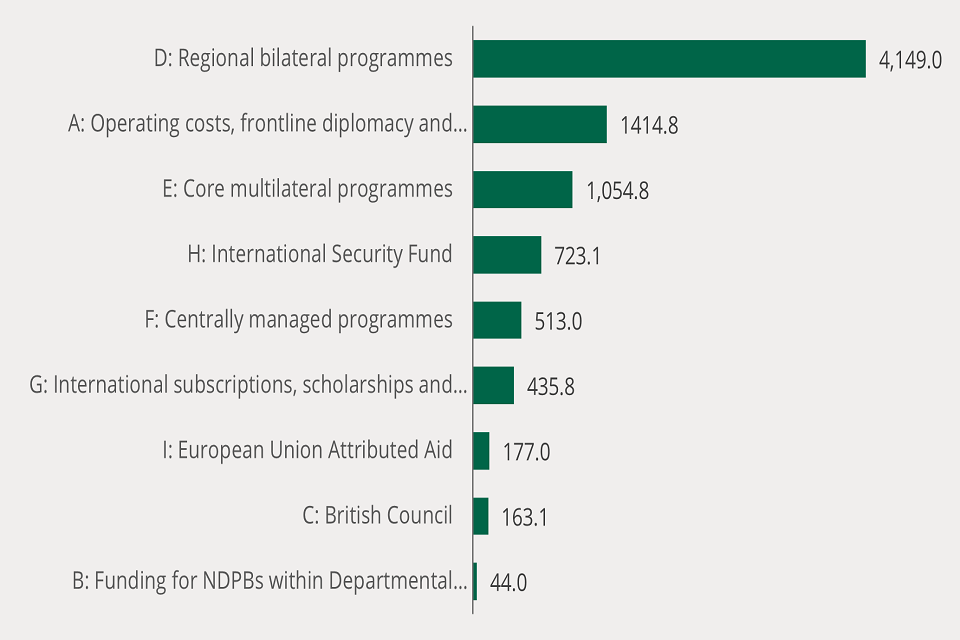
Capital DEL by spending area in 2025 to 2026 (£ million)
(Total budget £3,438.7 million)
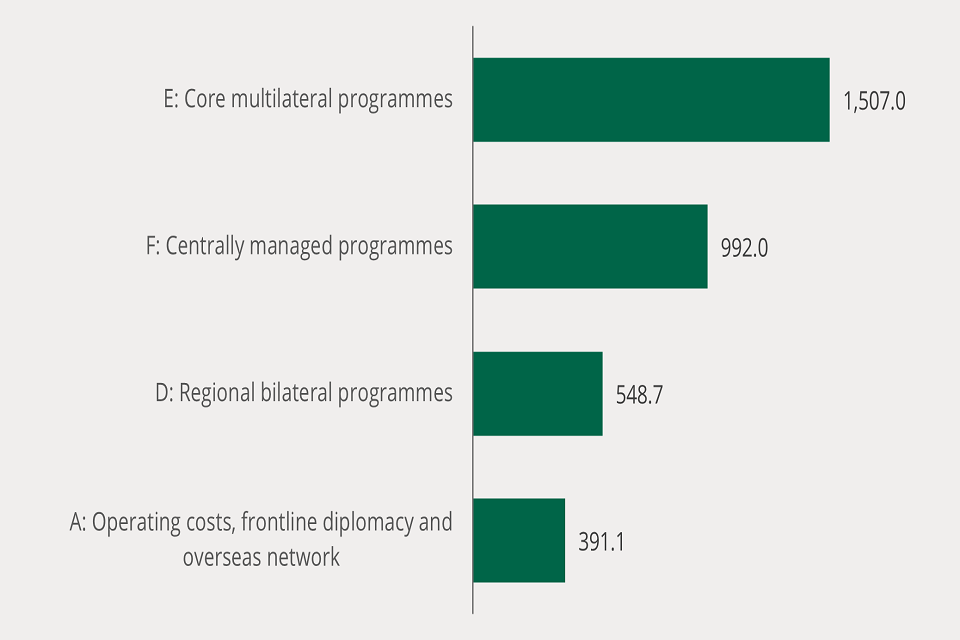
1.4. Comparison of spending totals sought
The table and graphic below show how the totals sought for the FCDO in its Main Estimate compare with last year and the latest Spending Review settlement (Autumn Budget 2024 (AB 2024)):
| Amounts sought this year £m (Main Estimate 2025 to 2026) | Difference £m (+/-) compared to final budget last year (Supplementary Estimate 2024 to 2025) | Difference % (+/-) compared to final budget last year (Supplementary Estimate 2024 to 2025) | Difference £m (+/-) compared to original budget last year (Main Estimate 2024 to 2025) | Difference % (+/-) compared to original budget last year (Main Estimate 2024 to 2025) | Difference £m (+/-) compared to Spending Review: AB 2024 | Difference % (+/-) compared to Spending Review: AB 2024 | |
|---|---|---|---|---|---|---|---|
| Resource DEL | 8675 | -55 | -1% | 503 | 6% | 401 | 5% |
| Capital DEL | 3439 | 702 | 26% | 680 | 25% | -479 | -12% |
| Resource AME | 539 | 18 | 3% | 18 | 3% | 539 | 100% |
| Capital AME | 481 | -400 | -45% | 61 | 15% | 481 | 100% |
FCDO budget comparison for Main Estimate 2025 to 2026 (£ million)
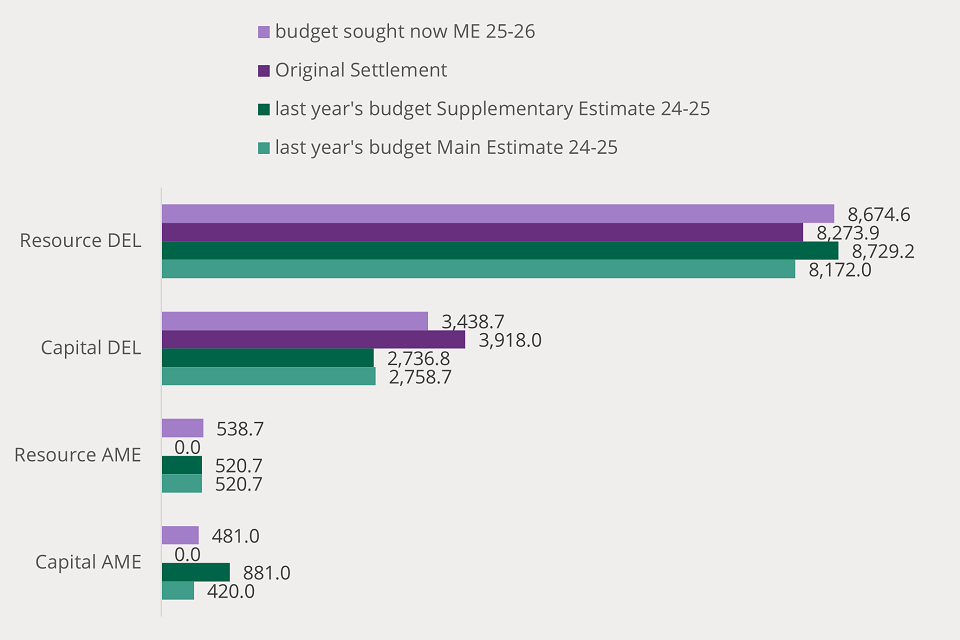
1.5. Key drivers of spending changes since last year
The main causes of the changes in Resource DEL are due to revised baselined budgets in the Phase 1 Spending Review 2024. This mainly includes:
- uplift to BBC World service budget by £42 million
- a reduction in the Integrated Security Fund of £15.7 million
The Spring Statement confirmed the impacts of the Government’s decision to reduce ODA to 0.3% of Gross National Income (GNI) by 2027 to fund increased defence spend.
All other spend is similar to 2024 to 2025.
1.6. Key drivers of change since the Spending Review
The levels of DEL funding for the FCDO for 2025 to 2026 are based on plans published in the 2024 Autumn Budget for the department. Since that time, the Government has made a number of changes to 2025 to 2026 spending plans. Details of funding changes are set out in the Table at Annex B.
Notable amongst Resource DEL changes are:
- machinery of government changes to transfer the Europe Framework to Cabinet Office £5.5 million
- uplift for National Insurance contributions £10.1 million
- allocation of depreciation budget excluded from the Phase 1 Spending Review £406.6 million
- switch for Voluntary Exit Scheme from Programme to Admin of £41.8 million
Notable amongst Capital DEL changes are:
- budget for British International Investment is received within the FCDO’s Capital DEL Financial Transactions budget before it is switched to Capital AME £480.0 million
1.7. Reserve claims and spending pressures
In 2025 to 2026 the FCDO will be operating within the Phase 1 Spending Review settlement received. Budgets will be monitored throughout the year to identify spending pressures. In line with the HM Treasury approach to reduce future Reserve access, any requirement to be drawn will be evaluated taut and realistically and will be raised ahead of the Supplementary Estimate 2025 to 2026.
1.8. Funding and other spending announcements
On Tuesday 25 February 2025, the Prime Minister announced that the UK will increase defence spending to 2.5% of GDP from 2027. This uplift will be funded through difficult but necessary reductions to development assistance from 0.5% to 0.3% of GNI, shifting to hard power capabilities whilst upholding fiscal discipline.
The Chancellor’s Spring Statement confirmed the changes in defence and ODA spending, including the ODA saving profile to 2029 to 2030. The Spring Statement also confirmed that ODA Department Expenditure Limit (DEL) totals will not be adjusted for GNI fluctuations to improve budget stability. As a result of this change, the FCDO no longer holds the ODA ‘spender and saver of last resort’ role, meaning the FCDO is no longer required to adjust budgets to hit a calendar year spending commitment, thereby increasing the predictability of its budgets.
The UK is committed to playing a significant role in international development; it is in our national interest and in the interests of our partners. The UK remains committed to returning to spending 0.7% of GNI on ODA as soon as the fiscal situation allows. As set out in the Spring Statement document, there will be a £0.5 billion reduction to 2025 to 2026 ODA budgets. Departmental splits are being worked through and will be confirmed shortly.
Details of all new funding announcements by the FCDO can be found on GOV.UK.
1.9. New policies and programmes; ambit changes
Details of all new policies and programmes announced by the FCDO can be found on GOV.UK.
There are no changes to the FCDO’s ambit in 2025 to 2026.
1.10. Administration costs and efficiency plans
Administration costs are set to increase by 12% in 2025 to 2026 compared to last year’s final budget. This is mainly due to a switch of £41.7 million from programme costs to cover the Voluntary Exit Scheme.
| Amounts sought this year £m (Main Estimate 2025 to 2026) | Difference £m (+/-) compared to final budget last year (Supplementary Estimate 2024 to 2025) | Difference % (+/-) compared to final budget last year (Supplementary Estimate 2024 to 2025) | Difference £m (+/-) compared to original budget last year (Main Estimate 2024 to 2025) | Difference % (+/-) compared to original budget last year (Main Estimate 2024 to 2025) | Difference £m (+/-) compared to Spending Review: AB 2024 | Difference % (+/-) compared to Spending Review: AB 2024 | |
|---|---|---|---|---|---|---|---|
| Administration costs | 388 | 42 | 12% | 35 | 10% | 85 | 28% |
The FCDO are committed to delivering overall savings and efficiencies in 2025 to 2026. Details of technical efficiencies will be provided in the next edition of the quarterly Government Efficiency Framework reporting.
1.11. Spending trends
The charts below show overall spending trends for the last five years, plans presented in Estimates for 2025 to 2026.
FCDO spending trends (£ million)
Capital and Resource DEL
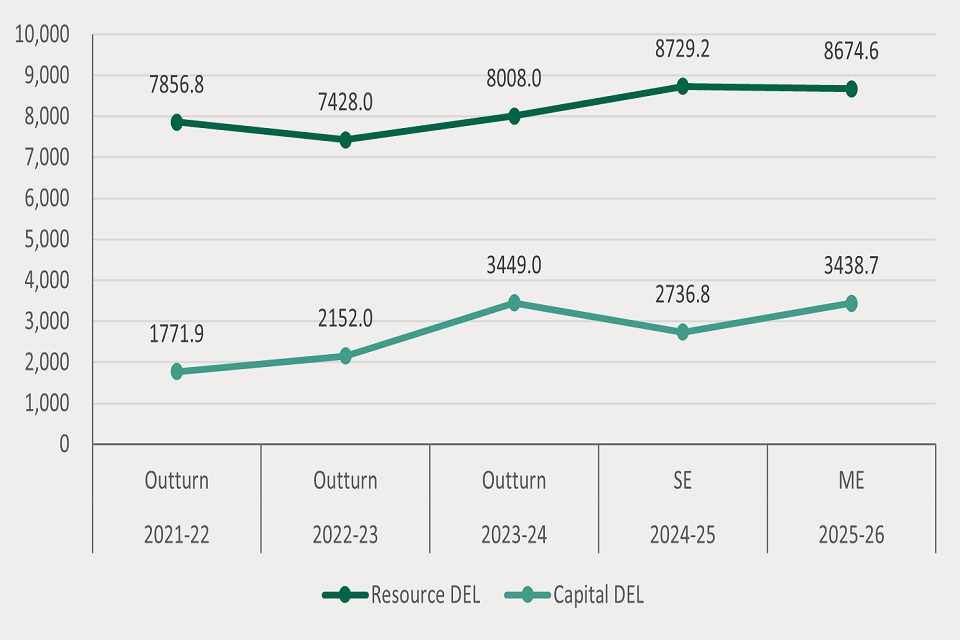
Capital and Resource AME
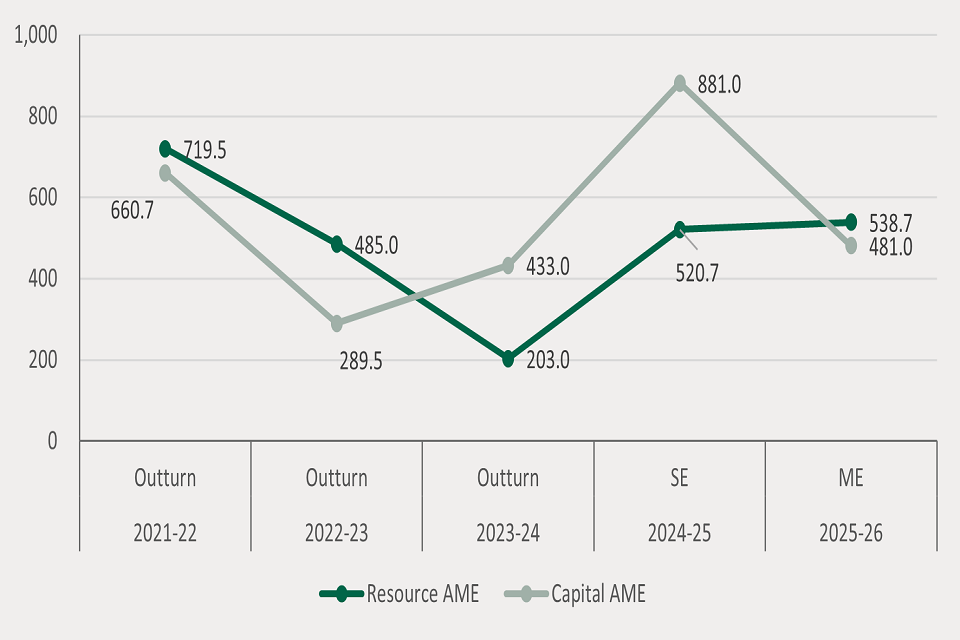
- Resource DEL has broadly remained stable between the Supplementary Estimate 2024 to 2025 and the Main Estimate 2025 to 2026
- Capital DEL has increased in 2025 to 2026 back to the 2023 to 2024 level following a £991 million ODA reduction in 2024 to 2025 to support in donor refugee costs
- Resource AME has been steadily increasing due to an increase in Financial Guarantees
- Capital AME has returned to 2023 to 2024 volumes after additional investment of £400 million in 2024 to 2025
2. Spending detail
2.1. Explanations of changes in spending
Resource DEL
The table comments below show how the FCDO’s spending plans for Resource DEL at the Main Estimate 2025-26 compared with the budget received in the Autumn Budget 2024.
| Subhead | Description | This year (2025 to 2026 Main Estimate budget sought) £m | Autumn Budget 2024 (Autumn budget approved) £m | Changes from the Autumn Budget £m | Changes from the Autumn Budget % | See note number |
|---|---|---|---|---|---|---|
| A | Operating costs, frontline diplomacy and overseas network | 1,414.8 | 1,312.1 | 102.7 | 8% | 1 |
| B | Funding for NDPBs within Departmental Group (Net) | 44.0 | 44.0 | 0.0 | 0% | |
| C | British Council | 163.1 | 163.1 | 0.0 | 0% | |
| D | Regional bilateral programmes | 4,149.0 | 4,134.1 | 14.9 | 0% | 2 |
| E | Core multilateral programmes | 1,054.8 | 1,054.1 | 0.7 | 0% | |
| F | Centrally managed programmes | 513.0 | 687.1 | -174.1 | -25% | 3 |
| G | International subscriptions, scholarships and BBC World Service | 435.8 | 435.8 | 0.0 | 0% | |
| H | Integrated Security Fund | 723.1 | 854.8 | -131.7 | -15% | 4 |
| I | European Union Attributed Aid | 177.0 | 0.0 | 177.0 | 100% | 5 |
Differences of more than 10% which are more than £10 million; of more than 5% and £200 million; and significant or unusual changes, are explained below. Numbers relate to the relevant row in the table above. Further detail of spending within these totals is given in the Annex Tables.
1. Operating costs, frontline diplomacy and overseas network
The net increase comprised mainly of:
- net budget transfers received of £101.5 million from other departments, comprising of £106.2 million for platform charges received and transfers out of £4.7 million
2. Regional bilateral programmes costs
The net increase comprised mainly of:
- a budget switch of £18.9 million from ISF Resource DEL to FCDO Resource DEL
- net budget transfers of £3.1 million to other departments, of which £2.1 million for the Overseas Territories Programme Fund
3. Centrally managed programmes costs
The net decrease comprised mainly of:
- a budget switch of £177.0 million from voted to non-voted for EU Attributed Aid. The budget for EU Attributed Aid is received within the FCDO’s voted programme budget. (See note 5 below)
- a budget switch of £4.1 million from ISF Resource DEL to FCDO Resource DEL
4. Integrated Security Fund (ISF)
The net decrease in the Integrated Security Fund comprised of:
- net budget transfers of £108.9 million to other departments
-
a budget switch of £22.8 million from ISF Resource DEL to FCDO Resource DEL. This comprises of:
- £18.9 million to Regional Bilateral Programmes
- £4.1 million to Centrally Managed Programmes
- £0.7 million to Core Multilateral Programmes
5. European Union Attributed Aid
Under the EU-UK Withdrawal Agreement, the UK will continue to meet outstanding commitments to EU development programmes, the EU budget (MFF 2014 to 2020) and the European Development Fund until around 2027. A budget switch of £177.0 million is requested from voted to non-voted for EU Attributed Aid.
Capital DEL
The table comments below show how the FCDO’s spending plans for Capital DEL at the Main Estimate 2025 to 2026 compared with the budget received in the Autumn Budget 2024.
| Subhead | Description | This year (2025 to 2026 Main Estimate budget sought) £m | Autumn Budget 2024 (Autumn budget approved) £m | Changes from the Autumn Budget £m | Changes from the Autumn Budget % | See note number |
|---|---|---|---|---|---|---|
| A | Operating costs, frontline diplomacy and overseas network | 391.1 | 390.8 | 0.3 | 0% | |
| D | Regional bilateral programmes | 548.7 | 548.3 | 0.4 | 0% | |
| E | Core multilateral programmes | 1,507.0 | 1,987.0 | -480.0 | -24% | 6 |
| F | Centrally managed programmes | 992.0 | 992.0 | 0.0 | 0% | |
| H | Integrated Security Fund | 0.0 | 0.0 | 0.0 | 0% |
Differences of more than 10% which are more than £10 million; of more than 5% and £200 million; and significant or unusual changes, are explained below.
6. Core multilateral programmes costs
The decrease of £480 million is from the budget switch from Capital DEL to Capital AME for British International Investment (BII) (See note 8 below).
Resource AME
The table comments below show how the FCDO’s spending plans for Resource AME at the Main Estimate 2025-26 compared with the budget received in the Autumn Budget 2024.
| Subhead | Description | This year (2025 to 2026 Main Estimate budget sought) £m | Autumn Budget 2024 (Autumn budget approved) £m | Changes from the Autumn Budget £m | Changes from the Autumn Budget % | See note number |
|---|---|---|---|---|---|---|
| J | Other central programme and technical costs | 538.7 | 0.0 | 538.7 | 100% | 7 |
Differences which are significantly above or below inflation are explained below.
7. Other central programme and technical costs
Resource AME is used primarily for accounting adjustments and by definition is volatile. The increase is due to an increase in Financial Guarantees.
Resource AME was not included in the scope of the Autumn Budget and is therefore requested in the Main Estimate.
Capital AME
The table comments below show how the FCDO’s spending plans for Capital AME at the Main Estimate 2025 to 2026 compared with the budget received in the Autumn Budget 2024.
| Subhead | Description | This year (2025 to 2026 Main Estimate budget sought) £m | Autumn Budget 2024 (Autumn budget approved) £m | Changes from the Autumn Budget £m | Changes from the Autumn Budget % | See note number |
|---|---|---|---|---|---|---|
| K | British International Investment | 481.0 | 0.0 | 481.0 | 100% | 8,9 |
Differences which are significantly above or below inflation are explained below.
8. British International Investment
Capital AME shows British International Investment’s (BII) forecast capital needs. The increase to Capital AME shows additional funding to recapitalise FCDO’s investment in British International Investment plc. Budget for British International Investment is received within the FCDO’s Capital DEL Financial Transactions budget before it is switched to Capital AME.
9. Provisions
The additional £1.0 million increase to the Capital AME budget is from the creation of a dilapidations provision.
2.2. Restructuring
In July 2024 the Prime Minister, Sir Keir Starmer, announced in a Written Ministerial Statement that the responsibility for the United Kingdom’s relationship with the European Union will move from the Foreign, Commonwealth and Development Office to the Cabinet Office. In the Main Estimate, the FCDO transferred £5.5 million as a Machinery of Government transfer to the Cabinet Office.
2.3. Ring-fenced budgets
Within the totals, administration, research and development, financial transactions, depreciation and the Integrated Security Fund, are ring-fenced and funding cannot be transferred into other parts of the core FCDO budget without HMT approval.
| Amounts sought this year £m (Main Estimate 2025 to 2026) | Difference £m (+/-) compared to final budget last year (Supplementary Estimate 2024 to 2025) | Difference % (+/-) compared to final budget last year (Supplementary Estimate 2024 to 2025) | Difference £m (+/-) compared to original budget last year (Main Estimate 2024 to 2025) | Difference % (+/-) compared to original budget last year (Main Estimate 2024 to 2025) | |
|---|---|---|---|---|---|
| Research and Development (CDEL) | 381 | -100 | -21% | -100 | -21% |
| Financial Transactions (CDEL) | 126 | -39 | -24% | -99 | -44% |
| Administration (RDEL) | 388 | 42 | 12% | 35 | 10% |
| Integrated Security Fund (TDEL) | 723 | -16 | -2% | -141 | -16% |
| Depreciation (RDEL) | 407 | 0 | 0% | 34 | 9% |
The reduction in ring-fenced Research and Development budget is due to forecasted requirements for 2025 to 2026.
The ring-fenced Financial Transactions budget appears smaller in 2025 to 2026 as the transfer to BII in the Main Estimate was £60 million larger than in 2024 to 2025.
The Administration ringfenced budget has increased by £41.7 million to allow for one-off costs relating to a Voluntary Exit Scheme.
The reduction in the Integrated Security Fund (ISF) arises from a reprofiling of ISF budgets resulting £22.8 million being transferred to the programme budget.
There have been no changes to the depreciation budget.
2.4. Changes to contingent liabilities
The FCDO’s contingent liabilities have increased by around £4.7 billion from the Supplementary Estimate 2024 to 2025 to the Main Estimate 2025 to 2026.
The increase mainly relates to financial guarantees of £4.8 billion which were not signed in the financial year 2024 to 2025 but might be in financial year 2025 to 2026, being World Bank guarantees of £1.6 billion for South Africa, £1.6 billion for Indonesia and £1.3 billion for Ukraine.
Additionally, a decrease of £0.2 billion is attributable to movements in underlying rates of guaranteed loans and principal repayments, reducing total exposure.
An increase of £0.05 billion relates to swings in foreign exchange on callable capital to Multilateral Development Banks (MDBs).
3. Priorities and performance
3.1. How spending relates to objectives
It is not possible to reflect the breakdown of resources by Priority as the FCDO is not structured in this way. Our resources, both people and projects, are cross cutting and delivery of our objectives contribute towards all of our Priorities.
3.2. Measures of performance against each priority outcome
Data on the FCDO’s 2024 to 2025 performance will be given in the FCDO 2024 to 2025 Annual Report and Accounts which will be published in Summer 2025.
3.3. Commentary on steps being taken to address performance issues
As part of the 2024 Autumn Budget settlement, £100.0 million Capital DEL from capital receipts and £50.0 million Resource DEL was baselined for the FCDO to fund its estates projects in 2025 to 2026. This marks a transition from self-funding to a sustainable funding model for the overseas estates’ portfolio.
The Capital DEL will continue to fund the contractually committed projects that are part of the estates programme of global new builds and refurbishments, and fund works on new offices in Geneva, Bamako, Djibouti and Miami, which will complete early in 2025 to 2026. There are also other large projects addressing urgent health and safety/end of life asset issues in Athens, Lagos, Nairobi, Luanda and Cairo. We continue to invest other capital in a long pipeline of smaller projects.
The Resource DEL will continue to fund smaller estates projects helping to reduce the backlog on largely health and safety maintenance works.
3.4. Major projects
The FCDO will deliver the following major projects as defined by the Infrastructure and Projects Authority (IPA):
- a project which will refurbish and upgrade key buildings on the British Embassy compound in Tokyo
The following projects, although still on the 2023 to 2024 report, have now completed and will be removed from the next IPA report:
- Echo 2: a joint project with the British Council to provide new network, telephony and video-conferencing services
- a major refurbishment of the embassy and ambassador’s residence in Washington DC
Progress on major projects is recorded at: Infrastructure and Projects Authority Annual Report 2023 to 2024.
4. Other information
4.1. Additional specific information required by the select committee
The Spring Statement confirmed the impacts of the Government’s decision to reduce ODA to 0.3% of GNI by 2027 to fund increased defence spend. There will be a £0.5 billion reduction to 2025 to 2026 ODA budgets tracking a gradual reduction to 0.3% of GNI in 2027. Departmental splits for 2025 to 2026 are being worked through and will be confirmed shortly.
In a letter to the International Development Committee (IDC) Baroness Chapman has set out the changes to the approach for ODA for 2025 to 2026 following the 0.3% announcement. The letter confirms FCDO’s plans to allow for critical development work to continue, to honour live contractual agreements with partners, and to deliver on the Prime Minister’s commitment for the UK to continue to play a key humanitarian role.
5. Accounting Officer approval
This memorandum has been prepared according to the requirements and guidance set out by the House of Commons Scrutiny Unit, available on the Scrutiny Unit website.
The information in this Estimates Memorandum has been approved by myself as Departmental Accounting Officer.
Sir Oliver Robbins
Accounting Officer
Permanent Under-Secretary
Foreign, Commonwealth and Development Office
9 May 2025
